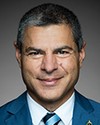Thank you, Mr. Chair, and good afternoon everybody.
I am pleased to appear before this committee to provide an overview of the Canada Border Services Agency and outline some of our key priorities.
My name is Nada Semaan and I'm the executive vice-president of the Canada Border Services Agency. I'm joined today by two members of our senior management team, Mr. Martin Bolduc, our vice-president of programs branch and Ms. Caroline Xavier, our vice-president of operations.
We have prepared a brief overview presentation for the committee's reference and will be happy to answer your questions.
In particular, Mr. Chair, we look forward to working with the members of this committee as you move forward on your mandate. The Canada Border Services Agency was established in December 2003. Its creation integrated border functions related to customs, immigration, enforcement, and food, plant, and animal inspection.
Today we are the second-largest law enforcement organization in the country.
While the environment in which we operate continues to evolve, the CBSA's dual mandate remains the same. We support both national security and economic prosperity by preventing the entry of those travellers or goods posing a potential threat to Canada while at the same time facilitating the flow of people and legitimate goods across the borders.
The Canada Border Services Agency Act is our enabling legislation. It sets out the responsibilities, mandate, powers, and duties of the Minister of Public Safety and Emergency Preparedness, as well as those of the president. We administer and enforce the Customs Act, which outlines our responsibilities to collect duties and taxes on imported goods, interdict illegal goods, and administer trade legislation and agreements.
With Immigration, Refugees and Citizenship Canada, we share responsibility for administering the Immigration and Refugee Protection Act, also known as IRPA. IRPA governs both the admissibility of people into Canada and the identification, detention, and removal of those deemed to be inadmissible under the act.
Finally, the agency enforces over 90 other statutes on behalf of federal departments and agencies.
To support this work, the agency has a total budget in 2015-16 of approximately $1.87 billion. Most of this budget covers operating expenditures required for ongoing border management. Included in this amount, the agency was allocated $223 million for investments in information technology and ports of entry, as well as $182 million for employee benefit plans.
We are a big operation and we function 24-7, 365 days a year. Our workforce of 14,000 employees includes approximately 6,700 uniformed border service officers who operate across Canada at airports, marine ports, land ports of entry, and remote border crossings, as well as overseas.
Our staff are proud and professional, and take their responsibilities seriously.
We have shared with the committee some presentation slides that give a sense of our operating environment, in order to highlight the important role the agency plays in supporting Canada's security and prosperity both at home and abroad.
You'll also see that we shared with you a little handy cheat sheet that shows that we processed last year approximately 97.5 million travellers who entered Canada, which means that the agency processed over 260,000 travellers on an average day.
One-third of these travellers arrived by air and close to two-thirds, by land.
We processed tens of millions of commercial shipments. In terms of trade between Canada and the United States alone, the CBSA facilitated approximately $1.4 million in goods every minute last year.
We collected about $29 billion in duties and taxes, which accounts for 10% of the Government of Canada's revenues.
We made over 8,000 drug seizures worth over $400 million; 7,400 weapons and firearms seizures; and 43,000 seizures of prohibited food, plants, and animals.
Finally, we removed over 11,000 individuals who were deemed inadmissible to Canada.
The CBSA is the first point of contact for travellers and goods arriving to Canada. We are, in effect, the face of Canada.
As such, underpinning our efforts is a strong commitment to service excellence rooted in our core values of integrity, respect, and professionalism. For travellers and trade partners, our goal is to help them reach their destination with minimal interventions. For importers and exporters, we want to ensure that appropriate regulations and laws are applied and that duties and taxes are collected.
We publish and report on our service standards on our website. There are a variety of internal and external complaint and redress mechanisms available for both the public and businesses.
Our work is organized along four major business lines, plus the internal services that are required to support the agency. First is the traveller program, which aims at facilitating the flow of admissible travellers. The commercial and trade program concentrates on the importation and export of commercial goods. The enforcement and intelligence program identifies high risks and targets before people and goods enter Canada, enforces customs and immigration laws, and pursues criminal prosecution. The border services management program involves the development of our frontline border service officer workforce, our supporting infrastructure, and our innovation in science and engineering.
Internal services refers to the information technology and corporate processes that support our business.
Border management is increasingly complex and requires global co-operation. By 2025 it is expected that global trade, the flow of goods and services and finance, will be worth approximately $85 trillion dollars. Up to 50% of the world's GDP is based on trade, with most growth expected in emerging economies. Trade flows and what we do at the border impact Canada's GDP.
At the same time, we must keep pace with emerging security risks like cyber-attacks, and improve our security monitoring to detect, for example, synthetic designer drugs, or insects and organisms that could compromise our food supply or our natural environment.
Organized cross-border crime is increasingly networked and tech-savvy, which demands vigilance.
The effects of the global refugee crisis led last year to the largest mass migration since World War II, and one that the agency has been particularly involved in with the screening and admission of 25,000 Syrian refugees. At the same time, we work with global and domestic partners in countering or preventing a range of threats, be they posed by organized crime, human smugglers, terrorists, or global human and/or animal health.
Partnerships are key to our agency's effectiveness.
Naturally, we work closely with our Government of Canada partners—most closely with other agencies in the public safety portfolio, who you will be hearing from next week.
We also have strong working relationships with provincial and municipal law enforcement agencies across the country.
We consult frequently with airport and bridge authorities, where there is significant interest in working with us to modernize infrastructure.
Industry stakeholders as well, such as the Business Council of Canada, the Canadian Federation of Independent Business, Canadian Manufacturers and Exporters, as well as the Canadian/American Border Trade Alliance, and the Pacific NorthWest Economic Region are all key interlocutors and important partners in our modernization efforts. Internationally we have an important relationship with the United States for both security and economic prosperity. The CBSA also works mostly with the Department of Homeland Security and its constituent parts, U.S. Customs and Border Protection, U.S. Citizenship and Immigration Services, and the U.S. Immigration and Customs Enforcement.
We have a growing relationship with Mexico, where there is an opportunity to expand co-operation in areas such as trusted travellers.
The CBSA also participates in an intelligence alliance with Australia, New Zealand, the United Kingdom, and the United States. We engage with these countries bilaterally and in different fora on border, trade, and security issues. We also play a constructive role through the World Customs Organization to work with large trading partners and with developing countries to promote common approaches and facilitate global trade flows.
Mr. Chair, I'm nearing the end of my presentation. I would end my opening remarks and conclude with a few words about some of our key priorities to improve border management.
We take pride in the agency's contribution to the whole-of-government effort to help resettle Syrian refugees. Over 21,000 refugees have arrived in Canada to date. The CBSA has been a key player, both through overseas security screening and through the processing of newcomers upon landing.
We continue to help strengthen trilateral North American co-op eration with the United States and Mexico.
This includes working in areas that improve border security while supporting trade and facilitating the movement of people. The CBSA continues to innovate in order to better serve clients and modernize border efficiency and security. To this end, we have a number of transformative information technology projects under way.
Finally, we are making a significant effort to upgrade more than 70 land ports of entry located across the country.
For these reasons, Mr. Chair, it is truly a rewarding and exciting time to be working at the Canada Border Services Agency.
I do thank you for your attention while I went through our processes. My colleagues and I would be pleased to answer any questions you may have.










